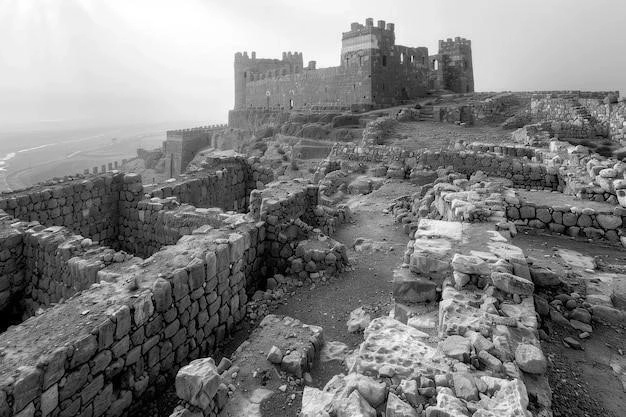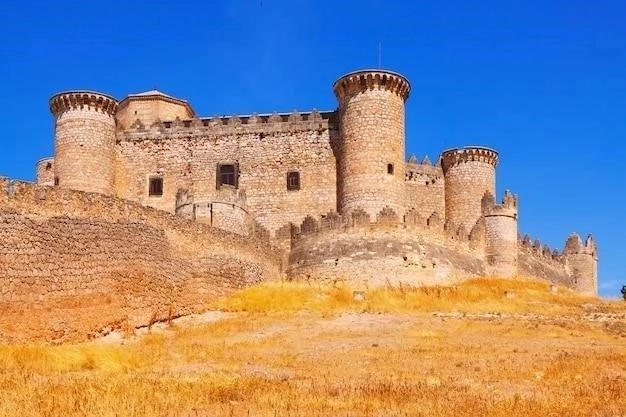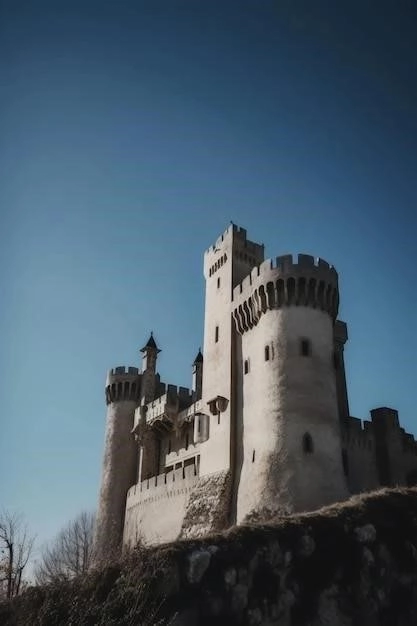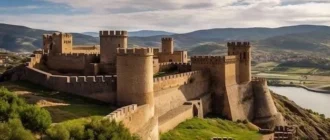Nestled amidst the bustling urban sprawl of Mumbai‚ the Sion Fort stands as a silent sentinel‚ a testament to the citys rich and layered history. This unassuming structure‚ often overlooked in the shadow of Mumbais more glamorous attractions‚ holds within its weathered walls tales of colonial struggles‚ strategic importance‚ and the enduring spirit of a city in constant flux.
A Strategic Outpost
The Sion Fort‚ also known as Sion Hillock Fort‚ owes its existence to the strategic considerations of the British East India Company. Erected between 1669 and 1677 during the governorship of Gerard Aungier‚ the fort was strategically positioned atop a conical hillock‚ providing a commanding view of the surrounding landscape.
At the time of its construction‚ the Sion Fort marked a crucial boundary. It stood as a dividing line between the British-held Parel Island and the Portuguese-controlled Salsette Island. The forts strategic location allowed the British to monitor the movements of potential adversaries and safeguard their burgeoning commercial interests in the region. The Mahim Creek‚ a vital trade route‚ flowed nearby‚ further amplifying the forts strategic significance.
Architectural Simplicity and Functionality
Unlike some of the grander and more ornate forts found across India‚ the Sion Fort is characterized by its architectural simplicity and functionality. Constructed primarily for defense‚ the fort features a robust quadrilateral structure with a triangular projection‚ a design reminiscent of the nearby Worli Fort.
The Sion Forts walls‚ built from locally sourced basalt dress stones and reinforced with sturdy wooden beams‚ have withstood the test of time‚ albeit bearing the marks of weather and neglect. The forts interior‚ while not as elaborate as some of its counterparts‚ housed barracks for soldiers‚ storage spaces for ammunition and provisions‚ and a system of underground tunnels‚ some of which are believed to still exist‚ shrouded in mystery.

From Bastion to Heritage Site: A Transformation
With the passage of time and the shifting tides of power‚ the Sion Forts military significance gradually diminished. The once formidable bastion transformed into a silent observer‚ witnessing the rapid growth and transformation of Mumbai from a collection of islands into a bustling metropolis.
Recognizing its historical and architectural importance‚ the Sion Fort was designated as a Grade I Heritage structure in 1925. Today‚ the fort and its surrounding ten-acre plot are under the protection of the Archaeological Survey of India (ASI)‚ a testament to its enduring legacy.
The Sion Fort Today: A Blend of Neglect and Renewal
Despite its heritage status‚ the Sion Fort bears the scars of neglect and the relentless march of time. The walls‚ once formidable‚ are weathered and crumbling in places‚ bearing the graffiti of a thousand passing hands. The lack of basic amenities‚ informative signage‚ and dedicated tourist facilities further detracts from the visitor experience.
However‚ amidst the neglect‚ there are glimmers of hope and renewal. The ASI‚ in collaboration with the Brihanmumbai Municipal Corporation (BMC)‚ has undertaken some restoration efforts‚ repairing damaged walls and strengthening vulnerable sections. The BMC has also developed a sprawling garden within the forts grounds‚ providing a much-needed green lung amidst the concrete jungle.
The garden‚ with its open-air study center and a childrens play area‚ attracts a diverse crowd‚ from fitness enthusiasts seeking a morning jog to students seeking a quiet space for contemplation. The fort also serves as an unlikely training ground for aspiring dancers from nearby communities‚ their energetic routines adding a vibrant touch to the historical setting.
The Future of Sion Fort: A Call for Preservation and Awareness
The Sion Fort‚ despite its current state of neglect‚ holds immense potential. Its strategic location‚ coupled with its historical and architectural significance‚ makes it an ideal candidate for restoration and development as a heritage tourism destination.
A comprehensive conservation plan‚ focusing on structural restoration‚ improved accessibility‚ informative signage‚ and the creation of visitor amenities‚ could transform the Sion Fort into a must-visit destination for history buffs‚ architecture enthusiasts‚ and anyone seeking a glimpse into Mumbais layered past.
Beyond its potential as a tourist attraction‚ the Sion Fort has the potential to become a vibrant community space. Educational programs‚ cultural events‚ and guided tours could help raise awareness about the forts rich history and foster a sense of ownership among local communities.
The Sion Fort‚ a silent sentinel overlooking Mumbais ever-changing skyline‚ is a poignant reminder of the citys rich history and the enduring power of human endeavor. It stands as a call to action‚ urging us to preserve and protect our shared heritage for generations to come. With concerted efforts from authorities‚ conservationists‚ and the community‚ the Sion Fort can be restored to its former glory‚ becoming a vibrant symbol of Mumbais resilience and its ability to embrace both the old and the new.
Challenges and Opportunities in Conservation
The path towards revitalizing Sion Fort is not without its challenges. As with many heritage sites in rapidly developing urban environments‚ Sion Fort faces constant pressure from encroaching development and limited resources. The lack of public awareness regarding the forts historical significance further complicates conservation efforts.
Addressing these challenges requires a multifaceted approach. Integrating the fort into a larger urban conservation plan that balances development with heritage preservation is crucial. This involves engaging with local communities‚ fostering a sense of ownership and pride in the site. Educational initiatives targeting schools and the general public can highlight the forts historical importance and generate support for its preservation.
Sion Fort: A Catalyst for Urban Renewal
The conservation of Sion Fort presents a unique opportunity to not only preserve a piece of history but also to catalyze urban renewal in the surrounding area. The forts strategic location and expansive grounds have the potential to be transformed into a vibrant cultural hub. Imagine:
- An open-air amphitheater nestled within the forts walls‚ hosting music performances‚ plays‚ and cultural events‚ bringing the community together.
- A heritage interpretation center‚ utilizing interactive exhibits and multimedia presentations to tell the story of the fort‚ from its colonial origins to its present-day significance.
- A revitalized garden space‚ designed with walking paths‚ seating areas‚ and perhaps even a café‚ providing a tranquil escape from the citys hustle and bustle.
By integrating the fort into the fabric of the city‚ it can become a vibrant public space‚ a source of pride for residents‚ and a magnet for tourists seeking a glimpse into Mumbais multifaceted past.
A Call to Action: Preserving History‚ Enriching the Present
The Sion Fort stands as a silent plea for recognition and renewal‚ a tangible link to Mumbais rich and layered past. Its preservation is not merely an act of nostalgia but a responsibility to future generations. By investing in its conservation‚ we not only honor the legacy of those who came before us but also create a valuable resource for education‚ recreation‚ and cultural enrichment.
It is time for Sion Fort to reclaim its rightful place as a vibrant landmark‚ a testament to Mumbais enduring spirit and its ability to weave together the threads of history‚ culture‚ and progress. Let us heed the call to action‚ working together to ensure that this historical gem continues to shine brightly for generations to come.
Leveraging Technology for Conservation and Engagement
The preservation of Sion Fort‚ like many heritage sites globally‚ can be significantly enhanced through the strategic integration of technology. Digital documentation‚ utilizing high-resolution 3D scanning and photogrammetry‚ can create an accurate and lasting record of the fort’s current state. This detailed digital twin can serve as a vital tool for conservation planning‚ structural analysis‚ and virtual restoration efforts.
Furthermore‚ augmented reality (AR) and virtual reality (VR) technologies offer exciting opportunities to enhance visitor engagement and understanding. Imagine visitors using AR apps on their smartphones or tablets to overlay historical images onto the present-day view‚ virtually peeling back layers of time to reveal the fort’s evolution. Immersive VR experiences can transport visitors back to the 17th century‚ allowing them to witness the fort in its heyday‚ bustling with soldiers‚ traders‚ and daily life.
Fostering Public-Private Partnerships
Given the scale of conservation and development required‚ fostering collaborations between government agencies‚ private organizations‚ and local communities is paramount. Public-private partnerships can provide the necessary funding‚ expertise‚ and community engagement to ensure the long-term sustainability of the project.
Corporate sponsorships‚ philanthropic donations‚ and grants from heritage conservation organizations can provide the financial impetus for restoration efforts. Partnering with universities and research institutions can provide access to cutting-edge conservation techniques and archaeological expertise. Engaging local communities in the planning and implementation phases ensures that the project aligns with their needs and aspirations‚ fostering a sense of shared ownership.

Positioning Sion Fort Within Mumbais Cultural Tourism Landscape
Sion Fort has the potential to become a key attraction within a revitalized cultural tourism circuit in Mumbai. By developing thematic walking tours that connect the fort to other nearby heritage sites‚ such as the Sewri Fort and the Mahim Dargah‚ visitors can experience a more comprehensive and enriching journey through the city’s history.
Promoting Sion Fort as a venue for cultural events‚ such as heritage festivals‚ sound and light shows‚ and theatrical performances‚ can attract both local and international audiences‚ generating revenue and raising the fort’s profile. Developing tourist-friendly infrastructure‚ such as clear signage‚ well-maintained pathways‚ restrooms‚ and a visitor center with interpretive displays‚ is essential to enhance the visitor experience.
Conclusion: A Legacy Preserved‚ a Future Envisioned
The Sion Fort‚ though bearing the patina of time‚ stands as a resilient symbol of Mumbai’s rich and layered history. Its conservation is not simply about preserving crumbling walls but about safeguarding a collective memory and inspiring future generations. By embracing a holistic approach that combines meticulous conservation‚ innovative technology‚ community engagement‚ and sustainable tourism practices‚ we can ensure that Sion Fort reclaims its rightful place as a vibrant cultural hub and a source of pride for Mumbai.
The journey towards revitalizing Sion Fort requires a shared vision and a collaborative spirit. It is a call to action for government agencies‚ conservationists‚ architects‚ historians‚ technology experts‚ local communities‚ and all those who believe in the power of heritage to connect us to the past‚ enrich the present‚ and inspire the future. Let us work together to ensure that this silent sentinel continues to bear witness to the unfolding story of Mumbai for centuries to come.
Sion Fort: A Blueprint for Sustainable Heritage Management in Mumbai
The conservation and adaptive reuse of Sion Fort presents a compelling case study for sustainable heritage management in a rapidly evolving urban context like Mumbai. The forts preservation should not be viewed as an isolated endeavor but rather as an integral component of a broader strategy for urban regeneration and cultural tourism development.
Integrating Sion Fort into a Network of Heritage Sites
A comprehensive approach to heritage management involves recognizing the interconnectedness of historical sites and their potential to create a cohesive narrative. Sion Fort should be integrated into a network of nearby heritage sites‚ such as:
- Sewri Fort: A late 17th-century fortification situated on the eastern waterfront‚ offering panoramic views of the harbor and a stark contrast to Sion Forts inland location.
- Mahim Dargah: A revered Sufi shrine dating back to the 15th century‚ reflecting the citys diverse religious heritage and spiritual traditions.
- Bandra Fort (Castella de Aguada): A Portuguese-built fort perched on a hilltop overlooking the Arabian Sea‚ providing insights into the citys colonial past.
Developing well-defined heritage trails that connect these sites through walking tours‚ guided excursions‚ and interpretive signage can create a more immersive and enriching experience for visitors. This interconnected approach not only enhances the tourism potential of individual sites but also fosters a greater appreciation for the citys multifaceted history.
Community Engagement as a Cornerstone of Sustainability
The long-term success of any heritage conservation project hinges on the active participation and support of local communities. Engaging residents in the planning and implementation phases of Sion Fort’s revitalization is crucial for several reasons:
- Local Knowledge: Residents possess invaluable insights into the forts history‚ its significance within the community‚ and potential challenges that need to be addressed.
- Sense of Ownership: Involving the community fosters a sense of ownership and pride‚ encouraging residents to become active stakeholders in the forts preservation.
- Sustainable Practices: Engaging residents can lead to the identification of sustainable practices and initiatives that align with the communitys needs and values.
Establishing community liaison groups‚ organizing workshops and consultations‚ and incorporating local perspectives into the decision-making process are essential steps in building a truly sustainable heritage management model.
Economic Viability and Sustainable Tourism
While the cultural and historical value of Sion Fort is undeniable‚ its long-term preservation requires a sustainable economic model. Developing responsible tourism initiatives that generate revenue while minimizing negative impacts on the site is paramount. This can be achieved through:
- Regulated Access and Ticketing: Implementing a nominal entrance fee for visitors can generate funds for maintenance and conservation efforts.
- Curated Tours and Experiences: Offering specialized tours‚ such as historical walks‚ photography excursions‚ and cultural performances‚ can enhance visitor engagement and generate revenue.
- Local Partnerships: Collaborating with local businesses‚ such as restaurants‚ craft shops‚ and tour operators‚ can create economic opportunities for the community and enhance the visitor experience.
Striking a balance between generating revenue and preserving the fort’s historical integrity is essential for ensuring the sustainability of this invaluable heritage asset.
Conclusion: A Legacy for Future Generations
The Sion Fort stands as a testament to Mumbai’s enduring spirit and its ability to embrace both tradition and progress. By adopting a holistic and forward-thinking approach to its conservation and management‚ we can ensure that this historical gem continues to inspire generations to come. The blueprint for sustainable heritage management lies in recognizing the interconnectedness of history‚ community‚ and economic viability. Through collaborative efforts and a shared commitment to preservation‚ Sion Fort can reclaim its rightful place as a vibrant cultural hub and a source of pride for Mumbai.
Leveraging Technology for Enhanced Preservation and Accessibility
The integration of technology presents a unique opportunity to elevate the Sion Fort experience while simultaneously aiding in its preservation. These advancements can be strategically implemented in several ways:
- 3D Laser Scanning and Modeling: Creating a comprehensive digital replica of the fort allows for detailed documentation of its current condition. This serves as a baseline for monitoring deterioration‚ planning precise restoration efforts‚ and even virtually reconstructing lost or damaged elements.
- Augmented Reality (AR) Experiences: Imagine visitors holding up their smartphones or tablets and seeing the fort come alive with superimposed historical imagery‚ information about architectural details‚ or even interactive reenactments of key events. AR has the power to make history tangible and engaging for a wider audience.
- Virtual Tours and Online Accessibility: Developing high-quality virtual tours of the fort makes it accessible to a global audience‚ including those with mobility limitations or those unable to travel to Mumbai. This can be a valuable tool for education‚ research‚ and promoting cultural exchange.

A Model for Urban Heritage Management
The Sion Fort project has the potential to serve as a replicable model for urban heritage management not just in Mumbai‚ but in cities around the world grappling with similar challenges. Key takeaways include:
- Holistic Approach: Successful heritage preservation demands a multifaceted approach that encompasses conservation‚ interpretation‚ community engagement‚ and sustainable economic development.
- Adaptive Reuse: Identifying innovative and contextually appropriate uses for historic structures ensures their relevance and economic viability in the 21st century.
- Technology as an Enabler: Embracing technological advancements allows for more effective conservation‚ enhanced visitor experiences‚ and broader accessibility to cultural heritage.
By sharing best practices and lessons learned from the Sion Fort project‚ Mumbai can contribute to a global dialogue on how to best protect and leverage our shared heritage for the benefit of present and future generations.

Sion Fort: A Blueprint for Sustainable Urban Heritage Management
The conservation and adaptive reuse of Sion Fort presents a compelling case study in balancing historical preservation with contemporary urban needs. Beyond its intrinsic historical significance‚ the forts strategic location within a densely populated urban fabric positions it as a potential catalyst for social revitalization and economic development.
Fostering a Dialogue Between Past and Present
The challenge lies in creating a dynamic space that respects the forts historical integrity while also catering to the evolving needs of the surrounding community. This necessitates a nuanced understanding of the forts various layers of history and their impact on the urban landscape.
- Archaeological Investigations and Documentation: Conducting thorough archaeological surveys and research can reveal hidden architectural elements‚ uncover forgotten narratives‚ and inform more accurate historical interpretation.
- Adaptive Reuse Strategies: Repurposing existing structures within the fort for compatible uses‚ such as a museum‚ cultural center‚ library‚ or performance space‚ can breathe new life into the site while generating revenue for its upkeep. Careful consideration should be given to minimizing interventions and using reversible‚ conservation-grade materials.
- Landscape Design as a Unifying Element: Developing a sensitive landscape plan that complements the forts historical character while providing green space‚ recreational areas‚ and improved pedestrian access can enhance the visitor experience and benefit the surrounding community.
Creating a Network of Heritage Sites
Viewing Sion Fort in isolation would be a disservice to its potential impact. Integrating the fort into a broader network of heritage sites within Mumbai can create a more cohesive and enriching tourism experience. Consider these strategic linkages:
- Sewri Fort: Located just a short distance from Sion Fort‚ this 17th-century structure offers a contrasting perspective on Mumbais colonial past. Developing a joint ticketing system or themed tours that connect the two forts can encourage visitors to explore a wider historical context.
- Kanheri Caves: Situated within the Sanjay Gandhi National Park‚ these ancient Buddhist cave temples showcase a much earlier chapter in Mumbais history. Promoting Sion Fort as a gateway to exploring these caves can diversify the citys tourism offerings and highlight the interconnectedness of its heritage.
- Chhatrapati Shivaji Maharaj Vastu Sangrahalaya: Formerly the Prince of Wales Museum‚ this institution houses a vast collection of Indian art‚ archaeology‚ and natural history. Partnering with the museum to develop exhibitions or educational programs related to Sion Fort can deepen visitors understanding of the forts significance within a broader historical narrative.
Community Engagement: Cultivating Stewardship and Ownership
The long-term success of Sion Fort hinges on active community participation. Fostering a sense of ownership and stewardship among local residents is crucial. This can be achieved through:
- Consultative Planning and Design: Engaging residents‚ local historians‚ and community organizations in the planning and design process ensures that the revitalized fort reflects the aspirations and needs of the community it serves.
- Educational Programs and Outreach: Developing educational programs‚ workshops‚ and guided tours tailored to different age groups can instill a deeper appreciation for the forts history and cultural significance.
- Community Events and Festivals: Hosting cultural events‚ music performances‚ or local craft fairs within the forts grounds can transform it into a vibrant public space and a source of community pride.
Economic Sustainability: A Multi-Pronged Approach
To ensure the long-term financial viability of Sion Fort‚ a diversified revenue stream is essential. This can be achieved through a combination of:
- Entrance Fees and Ticketing: Implementing a nominal entrance fee for visitors can generate consistent revenue for the forts maintenance and operations. Offering discounted rates for students‚ seniors‚ and local residents can ensure accessibility for all.
- Venue Rental for Private Events: Leasing out designated areas within the fort for private events such as weddings‚ corporate gatherings‚ or film shoots can provide a significant income source. Strict guidelines should be enforced to prevent damage to the historical structure.
- Partnerships with Local Businesses: Collaborating with nearby restaurants‚ hotels‚ and tour operators can create mutually beneficial partnerships that drive tourism to the area and generate economic activity.
Conclusion: Sion Fort as a Beacon of Urban Regeneration
The revitalization of Sion Fort presents a unique opportunity to not only preserve a valuable piece of Mumbais heritage but also to create a vibrant public space that benefits the entire city. By embracing a holistic approach that integrates conservation‚ adaptive reuse‚ community engagement‚ and economic sustainability‚ Sion Fort can become a shining example of how to leverage cultural heritage as a catalyst for urban regeneration. The lessons learned from this project can serve as a model for other cities around the world seeking to breathe new life into their own historic treasures.
Sion Fort: A Beacon of Urban Regeneration (Continued)
Addressing the Challenges of Heritage Management in a Megacity
The Sion Fort project is not without its hurdles. Mumbais rapid urbanization‚ coupled with the complexities of managing a site of such historical significance‚ presents ongoing challenges:
- Encroachment and Development Pressures: The forts proximity to densely populated areas requires proactive measures to mitigate encroachment and prevent unauthorized construction that could compromise its integrity. This necessitates a coordinated effort between government agencies‚ urban planners‚ and community stakeholders to establish clear boundaries and enforce zoning regulations.
- Environmental Degradation and Pollution: Air and noise pollution from traffic congestion and industrial activity pose a threat to the forts structural integrity and detract from the visitor experience. Implementing green infrastructure initiatives‚ such as urban forestry programs and pedestrian-friendly walkways‚ can help mitigate these environmental stressors.
- Funding Constraints and Resource Allocation: Securing adequate funding for the forts ongoing maintenance‚ conservation efforts‚ and programming requires a multi-faceted approach. Exploring public-private partnerships‚ seeking grants from heritage organizations‚ and establishing an endowment fund can provide long-term financial stability.
Leveraging Technology for Enhanced Heritage Interpretation and Management
Incorporating digital technologies into the Sion Fort experience can significantly enhance visitor engagement and facilitate more effective site management:
- Augmented Reality (AR) and Virtual Reality (VR) Applications: Developing AR/VR experiences can transport visitors back in time‚ allowing them to virtually explore the fort as it existed in different historical periods. This immersive technology can bring historical narratives to life and foster a deeper emotional connection to the site.
- Interactive Mobile Apps and Digital Signage: Creating user-friendly mobile apps with interactive maps‚ historical timelines‚ and multilingual audio guides can enrich the visitor experience and provide on-demand access to information. Strategically placed digital signage can offer wayfinding assistance‚ highlight points of interest‚ and display real-time information about events or exhibitions.
- Remote Sensing and 3D Modeling for Conservation: Utilizing drones equipped with high-resolution cameras and laser scanners to create detailed 3D models of the fort can aid in structural assessments‚ monitor for signs of deterioration‚ and guide conservation interventions with greater precision.
Sion Fort as a Model for Global Heritage Stewardship
The Sion Fort project holds immense potential not only for Mumbai but also as a case study for other cities grappling with the challenges of preserving cultural heritage in the face of rapid urbanization. By sharing best practices‚ lessons learned‚ and technological innovations‚ Mumbai can contribute to a global dialogue on sustainable heritage management. The revitalized Sion Fort can stand as a testament to the power of collaboration‚ innovation‚ and community engagement in safeguarding our shared cultural legacy for generations to come.










